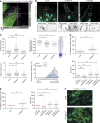Intermediate filaments control collective migration by restricting traction forces and sustaining cell-cell contacts
- PMID: 29980627
- PMCID: PMC6122997
- DOI: 10.1083/jcb.201801162
Intermediate filaments control collective migration by restricting traction forces and sustaining cell-cell contacts
Abstract
Mesenchymal cell migration relies on the coordinated regulation of the actin and microtubule networks that participate in polarized cell protrusion, adhesion, and contraction. During collective migration, most of the traction forces are generated by the acto-myosin network linked to focal adhesions at the front of leader cells, which transmit these pulling forces to the followers. Here, using an in vitro wound healing assay to induce polarization and collective directed migration of primary astrocytes, we show that the intermediate filament (IF) network composed of vimentin, glial fibrillary acidic protein, and nestin contributes to directed collective movement by controlling the distribution of forces in the migrating cell monolayer. Together with the cytoskeletal linker plectin, these IFs control the organization and dynamics of the acto-myosin network, promoting the actin-driven treadmilling of adherens junctions, thereby facilitating the polarization of leader cells. Independently of their effect on adherens junctions, IFs influence the dynamics and localization of focal adhesions and limit their mechanical coupling to the acto-myosin network. We thus conclude that IFs promote collective directed migration in astrocytes by restricting the generation of traction forces to the front of leader cells, preventing aberrant tractions in the followers, and by contributing to the maintenance of lateral cell-cell interactions.
© 2018 De Pascalis et al.
Figures





References
Publication types
MeSH terms
Substances
LinkOut - more resources
Full Text Sources
Other Literature Sources
Research Materials
Miscellaneous

